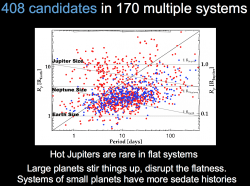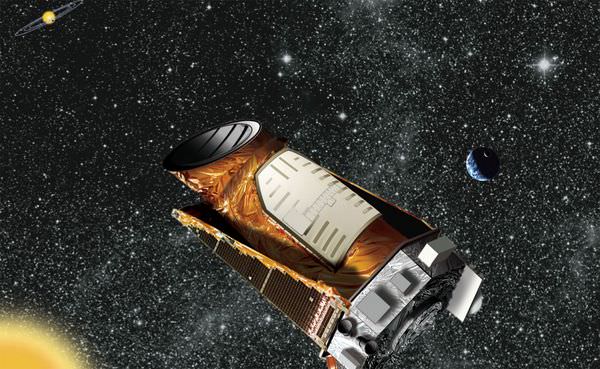[/caption]
Of the 1235 planetary candidates that NASA’s Kepler space telescope has found so far, 408 reside in multiple-planet systems – a growing trend that indicates planets do, in fact, like company.
The systems observed also seem to behave quite differently than our own solar system. In particular many are flatter than ours; that is, the planets orbit their stars in more or less the same exact plane. This, of course, is what allows Kepler to see them in the first place… the planets have to transit their stars perpendicular to Kepler’s point of view in order for it to detect the oh-so-subtle change in brightness that indicates the likely presence of a planet. In our solar system there’s a variation in the orbital plane of some planets up to 7º – enough of a difference that an alien Kepler-esque telescope might very well not be able to spot all eight planets.
The reason for this relative placidity in exoplanet orbits may be due to the lack of gas giants like Jupiter in these systems. So far, all the multiple-planet systems found have planets smaller than Neptune. Without the massive gravitational influence of a Jupiter-sized world to shake things up, these exosystems likely experience a much calmer environment – gravitationally speaking, of course.
“Most likely, if our solar system didn’t have large planets like Jupiter and Saturn to have stirred things up with their gravitational disturbances, it would be just as flat. Systems with smaller planets probably had a much more sedate history.”
– David Latham, Harvard-Smithsonian Center for Astrophysics, Cambridge, MA

Systems containing large gas giants have also been found but they are not as flat as those without, and many smaller worlds are indeed out there… “probably including a lot of them comparable in size to Earth,” said planet-hunter Geoff Marcy of the University of California, Berkeley.
While multiple-planet systems were expected, the scientists on the Kepler team were surprised by the amount that have been discovered.
“We didn’t anticipate that we would find so many multiple-transit systems. We thought we might see two or three. Instead, we found more than 100,” said Latham.
A total of 171 multiple-planet systems have been found so far… with many more to come, no doubt!
Announced yesterday at the American Astronomical Society conference in Boston, these findings are the result of only the first four months of Kepler’s observations. There will be another news release next summer but in the meantime the team wants time to extensively research the data.
“We don’t want to get premature information out. There’s still a lot of analysis that needs to be done.”
– Kepler principal investigator William Borucki
Read more on the Kepler mission site, or on Science NOW.


Thanks for this timely update from the AAS meeting!
Estimating planetary system characteristics like multiple systems would be tricky business early on.
My immediate reactions are:
1. WOW! [As in “Worlds Of Wonder” too.]
2. We would miss some multiple systems anyway, and with the effect of Jupiters foremost, so it is a lower limit at that. But 2 orders of magnitude? This must be one of these collective “I don’t know where that came from, but I know I like it” moments.
3. The “Rare Earth” proponents will be correct due to the wide range of characteristics and diversity. But in a way they didn’t expect: most multiplanetary systems are likely much more ordered, dense and populated with potential habitable terrestrial type planets and moons than ours.*
———-
* Maybe balanced with a higher impact rate, which naively wouldn’t affect habitability as much. (A high impact rate seems survivable. At least for existing cellular life; OTOH impactors promote habitability by providing organics and energy for chemistry.)
But surely would affect multicellular ecology.
Torbjorn did you mean that the Rare Earth proponents would be incorrect not correct? I’m not sure I understand your comment.
Oh I should clarify that I’m not the author of this post, I just happen to have a similar name.
Nice! I simply can’t get enough articles about exoplanets. Eagerly await the JWST.
This stirring up by Jupiter and Saturn is one of the theses in my book. It over a long time period adjusted Earth’s orbit outwards to compensate for the increased heating of the sun. My calculations indicate that at the origin of the Earth it was at a .83AU distant from the less luminous sun. As a result the Earth had surface temperatures comparable to today instead of -30C on average.
I also use this physics to arrive at a rare Earth result as well. The perturbation by Jupiter is chaotic and one can compute the chaos factor called a Lyapunov exponent. I then did analysis of a putative 1AU orbit for extrasolar data on G class stars. The data is a bit old, going back to 2007, but only one other star system came at all close. The rest had jovians that would perturb an Earth-like planet far too much. I then did some Bayesian analysis and found that the galaxy might only have 1000 planets at all comparable to Earth. Data that has come forth since then does not look very good for supporting a common occurrence of planets like Earth.
LC
I’m not an astronomer, but couldn’t it be that we see more flat systems simply because they are the only ones we can spot? I mean if one of the supposedly flat systems had a planet with a large inclination we wouldn’t (most likely) ever detect that planet since it wouldn’t transit the star.
Couldn’t the surprising flatness of the planetary systems be just an artefact of our way of detecting planets? If one of the supposedly flat systems had a planet with a large inclination we wouldn’t be able to detect it, since it would (most likely) never transit the star, right?
The planetary systems discovered by Kepler will naturally look ‘flat’ and concist predominately by planets close to the star as only those have a high probability of actual transfers. Thats simply the selection criteria for detection.
If there are planets with an high inclination the will only transfer if the ‘ecliptical nodes’ coincide with our line-of-sight. That may very well happen, but it will be rare. If our solarsystem was one of the candidate stars examined by Kepler only Venus & Earth would have had a reasonable chance of detection yet, Mercury and Mars probably to small to stand out from noice, and Jupiter, Saturn etc still not having transfered. Venus & Earht might also be hard to detect, i dont know the limits here, it is atleast close.
The planetary systems discovered by Kepler will naturally look ‘flat’ and concist predominately by planets close to the star as only those have a high probability of actual transfers. Thats simply the selection criteria for detection.
If there are planets with an high inclination the will only transfer if the ‘ecliptical nodes’ coincide with our line-of-sight. That may very well happen, but it will be rare. If our solarsystem was one of the candidate stars examined by Kepler only Venus & Earth would have had a reasonable chance of detection yet, Mercury and Mars probably to small to stand out from noice, and Jupiter, Saturn etc still not having transfered. Venus & Earht might also be hard to detect, i dont know the limits here, it is atleast close.
That’s a very good point and something to keep in mind. Kepler has detected many Potential planets. The amount confirmed so far are going to be interesting sure, but shouldn’t discourage those looking for Earth 2.0. In order to confirm a planet, they must have a minimum of 3 transits. That means for an alien Kepler, it would take 3 years to confirm the Earth was here at all. Now think about how long it takes the further planets in our system to complete even a single orbit (even Jupiter is 11.86 years)